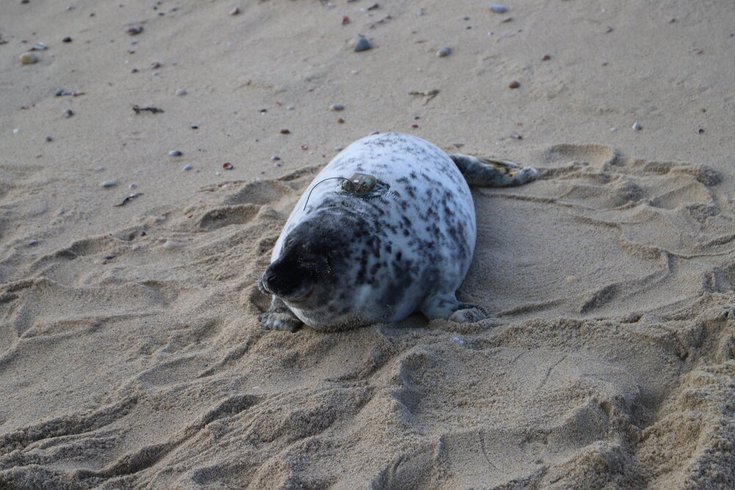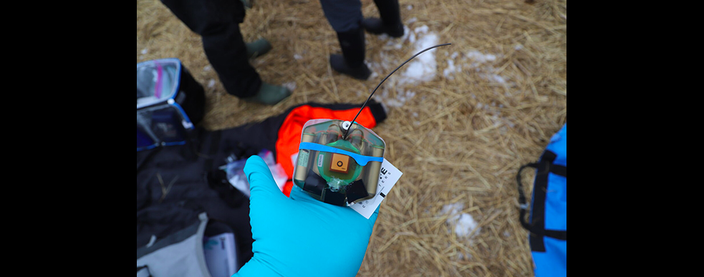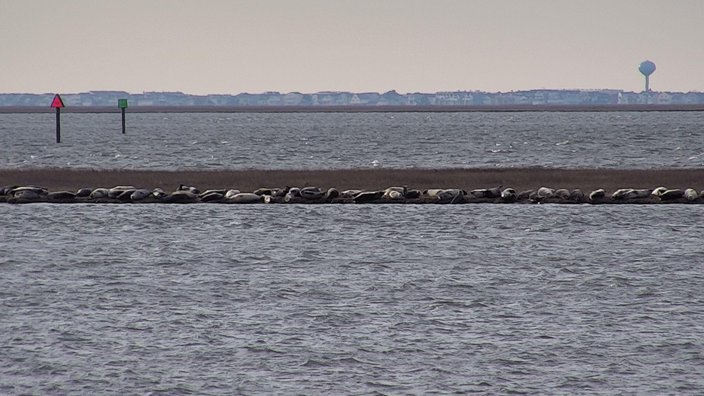
July 17, 2023
 Jackie Toth Sullivan/Stockton University
Jackie Toth Sullivan/Stockton University
New Jersey's harbor seal population will be tagged and tracked for the first time thanks to a grant given to Stockton University from the New Jersey Department of Environmental Protection.
New Jersey's harbor seal population will be tagged and tracked for the first time thanks to a grant gifted to Stockton University from the New Jersey Department of Environmental Protection.
The three-year, $682,890 grant was given to Stockton through the NJDEP's Research and Monitoring Initiative, which monitors New Jersey's marine resources through the phases of offshore wind development.
“The purpose of the study is to, first, better understand the movement patterns of harbor seals both in New Jersey, as well as regionally,” said Jackie Toth Sullivan, a marine mammal biologist and adjunct faculty member at Stockton. “We would like to understand if these harbor seals are using specific areas offshore for certain behaviors. For example, are windfarm lease areas being used as foraging grounds, and does this behavior change over time due to natural or anthropogenic impacts?”
In December, a team from Stockton's Marine Field Station in Port Republic will collaborate with organizations such as the Atlantic Marine Conservation Society, the Northeast Fisheries Science Center, Marine Mammals of Maine and the Naval Undersea Warfare Center to attach satellite tags to seals.
The tags will allow researchers to track the harbor seals as they spend winter in the mid-Atlantic region and migrate along the East Coast. During the tagging process, biological samples will be taken from the seals for health assessments as well as to fill data gaps in similar seal studies performed by other East Coast states. Stockton students will study the data next spring.
Harbor seals are common on the East Coast, often found in temperate coastal habitats from the Canadian Arctic down to the Mid-Atlantic regions, according to the National Oceanic and Atmospheric Administration.
The satellite tags, pictured above, will allow researchers to follow New Jersey's harbor seals as they spend the winter in the mid-Atlantic area and migrate to other areas along the East Coast.
The species, of the true seal family, can weigh up to 285 pounds and measure up to six feet long. The animal's diet consists of fish, shellfish and crustaceans. Harbor seals "haul out," or rest, on rocks, reefs, beaches and drifting glacial ice when not traveling or foraging.
At the Jersey Shore, as many as 360 seals gather at Ocean and Atlantic counties' Great Bay, the largest "haul-out" site for seals in New Jersey. Other known resting sites in New Jersey include Gateway National Recreation Area, where about 100 seals reside, and Barnegat Light on Long Beach Island, where about 30 seals can be seen.
As many as 360 harbor seals gather to rest and forage each winter in South Jersey's Great Bay, which is the largest haul-out (or resting) site for seals in the state of N.J.
Harbor seals typically stay within 15 to 31 miles from where they are born, but they sometimes travel hundreds of miles to give birth to pups or to eat seasonally available food. Harbor seals gather in New Jersey in October and November and usually stay through March or April.
The species' conservation status is considered "least concern" by the International Union for Conservation of Nature's Red List of Threatened Species, and harbor seals are protected under the Marine Mammal Protection Act. Threats that they face include entanglement, habitat degradation and chemical contaminants.
Through the satellite tagging project, researchers will collect seal data before offshore wind construction begins in New Jersey, giving them a baseline to assess whether seal health, behavior and movements are affected by offshore development, according to Stockton.
Ocean Wind 1, New Jersey's first offshore wind project, would be located 15 miles off the coast of South Jersey and deliver 1,100 megawatts of clean energy (enough to power half a million homes). The project, from the Danish energy company Ørsted, is still in the research stage, putting it roughly four years away from installation.
Follow Franki & PhillyVoice on Twitter: @wordsbyfranki
| @thePhillyVoice
Like us on Facebook: PhillyVoice
Have a news tip? Let us know.
 Jackie Toth Sullivan/Stockton University
Jackie Toth Sullivan/Stockton University